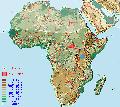hunti [S.](F)
Sergentomyia (Neophlebotomus) hunti (Lewis & Kirk, 1946)
CARACTERES DIAGNOSTIQUES
Le mâle de S. hunti se différencie par un AIII très long (460 à 530 µm) muni d'une épine géniculée. Chez la femelle, les dents du cibarium sont minuscules.
DESCRIPTION
Phlebotomus (Rondanomyia) hunti Lewis & Kirk, 1946. Proceedings of the Royal Entomological Society of London, 15 (5-6) : 55-6. [Femelle].
Statut actuel : Seccombe et al., 1993.
TYPE
Holotype femelle et paratypes (5 femelles), Soudan : sources Yubu, 10.VIII.1940 (Natural History Museum, Londres).
BIOLOGIE
Biotopes : terriers.
Développement larvaire: inconnu.
Fluctuations : inconnues.
Préférences trophiques : inconnues.
Importance médicale : rôle vecteur inconnu.
Sergentomyia (Neophlebotomus) hunti femelle
A. cibarium; B. pharynx; C. spermathèque; (RCA, N. Léger Coll.)
Sergentomyia (Neophlebotomus) hunti femelle
A. pharynx & cibarium; B. cibarium; C. 3ème & 4ème segments antennaires; D. spermathèque
ABDOMEN
AILE
- AILE : Largeur de l'aile (mm) F : > 0,50
- AILE : Longueur de l'aile (mm) F : > 2
- AILE : Rapport longueur / largeur de l'aile F : > 4 & <= 5 ; > 3 & <= 4
GENITALIA
PATTE I
RÉPARTITION
- RÉPARTITION : Espèces connues d'un pays donné : République Centrafricaine ; Soudan
- RÉPARTITION : Espèces connues d'un pays et des pays limitrophes : Tchad ; Soudan ; République Centrafricaine ; Ouganda ; Kenya ; Éthiopie ; Érythrée ; Congo Démocratique (ex-Zaïre) ; Congo ; Cameroun
SPERMATHÈQUE
- SPERMATHÈQUE : Aspect de la surface des conduits : non strié
- SPERMATHÈQUE : Base des conduits individuels : non dilaté
- SPERMATHÈQUE : Conduits individuels : séparés
- SPERMATHÈQUE : Forme de la tête : arrondie
- SPERMATHÈQUE : Forme générale du corps : en capsule allongée
- SPERMATHÈQUE : Tête de la spermathèque : invaginée
TÊTE
- TÊTE : Armature cibariale F : sans dents ou avec des dents rudimentaires
- TÊTE : Comparaison des segments antennaires AIII et AIV + AV : AIII > AIV + AV
- TÊTE : Denticules du cibarium F : irrégulièrement implantés
- TÊTE : Extrémité de l'hypopharynx : denticulée ; fortement ondulée ; faiblement ondulée ; lisse
- TÊTE : Extrémité des mandibules : dentée ; denticulée
- TÊTE : Forme de la plage pigmentée du cibarium : en raquette de ping-pong
- TÊTE : Forme du pharynx postérieur : rétréci postérieurement (en verre de lampe)
- TÊTE : Formule antennaire F : 2/III-XV
- TÊTE : Formule palpale F : 1-2-3-4-5 ; 1-2-(3-4)-5 ; 1-2-4-3-5 ; 1-(2-4)-3-5 ; 1-4-2-3-5 ; 1-4-2-5-3 ; 1-4-3-2-5 ; 1-4-(2-3)-5
- TÊTE : Longueur du segment antennaire AIII (µm) F : > 350
- TÊTE : Plage armée du pharynx F : absente ou rudimentaire
- TÊTE : Plage pigmentée du cibarium F : étendue sur toute la largeur du cibarium
- TÊTE : Rapport segment antennaire AIII / Epipharynx F : > 1.5 & <= 2
- TÊTE : Rapport segment antennaire AIV / ascoïde IV (c/b) F : >2 & <=3 ; >3 & <=4


